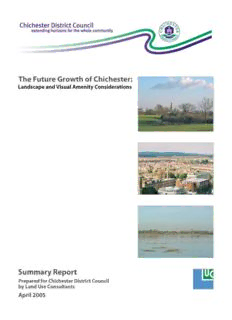
Landscape and Visual Amenity Considerations PDF
Preview Landscape and Visual Amenity Considerations
THE FUTURE GROWTH OF CHICHESTER: Landscape and Visual Amenity Considerations Prepared for Chichester District Council by Land Use Consultants SUMMARY REPORT April 2005 43 Chalton Street London NW1 1JD Tel: 020 7383 5784 Fax: 020 7383 4798 [email protected] CONTENTS 1. Introduction .........................................................................................1 2. Landscape Character Context...........................................................3 3. Visual Baseline: Priority Views...........................................................9 4. Landscape Character and Visual Amenity Considerations Relating to the Assessment of Development Potential ...............................13 5. Conclusions ........................................................................................23 FIGURES Figure number and name Location after page: Figure 1.1 Area of Search for Potential New Development 2 Figure 2.1 The Character of Chichester’s Landscape Setting 4 Figure 2.2 Detailed Landscape Character Types 8 Figure 2.3 Landscape Character Parcels 8 Figure 3.1 Zone of Visual Influence (ZVI) of Chichester Cathedral Spire 10 Figure 3.2 Priority Views – Views to Chichester Cathedral 12 Figure 3.3 Priority Views – Panoramic View from The Trundle (View 20) 12 Figure 3.4 Priority Views – Panoramic View from Stoke Clump (View 21) 12 Figure 3.5 Priority Views – View 22: View from Footpath along the Northern Edge of 12 Chichester Figure 3.6 Priority Views – View from Centurian Way north of New Cottages (View 23) and 12 View from Centurian Way at Hunters Race (View 24) Figure 4.1 Landscape Sensitivity 22 Figure 4.2 Sensitivity in Relation to Priority Views overlain with Viewcones to Chichester 22 Cathedral Figure 4.3 Sensitivity in Relation to Priority Views overlain with ZVIs for Views 20-24 22 Figure 4.4 Sensitivity in Relation to the Amenity for Local Viewers 22 i ACKNOWLEDGEMENTS Land Use Consultants (LUC) prepared this report on behalf of Chichester District Council. The study has been jointly funded by Chichester District Council and West Sussex County Council. The team consisted of Mark Lintell and Rebecca Knight (authors), Diana Graham (GIS), Lucas Greysmith (3D modelling and visualisations) and David Hares (historic research). The study has been steered by an Advisory Group comprising the following members: Jeff Lander Chichester District Council Michael Elkington West Sussex County Council Esmond Turner West Sussex County Council We are most grateful for the guidance and advice provided by the Advisory Group. However, the views and recommendations in this report are those of Land Use Consultants. The study has involved the gathering of existing data and information and we appreciate the time and trouble taken by those organisations and individuals involved in this exercise. In particular we are most grateful to Bob Connell and Dr Nicola Bannister who provided the historic landscape character assessment data, and to Mark Jennings who provided a large amount of GIS data on behalf of Chichester District Council. i 1. INTRODUCTION 1.1. Finding ways to accommodate the requirement for new housing is a key issue for local planning authorities. Although Government policies are designed to prioritise development on previously developed land, as set out in Planning Policy Guidance note 3: Housing (PPG 3), there is a need in some situations also to consider greenfield sites. In such circumstances, one of the most important challenges that local authorities face is to accommodate built development without undermining landscape and townscape character. 1.2. Chichester District Council commissioned Land Use Consultants in December 2004 to undertake a study of landscape and visual constraints to built development around Chichester. This study forms one of a series of constraints studies being undertaken by the Council to identify potential Development Options for accommodating the housing requirement. The final judgement on which, if any, Development Options should be taken forward will be made by weighing the evidence from all of the studies. 1.3. Our brief included what is described as the `Area of Search’ within which potential sites for new development might lie (see Figure 1.1) Approach to the Assessment 1.4. An important part of the evaluation of Development Options is to assess how what will inevitably be seen as major development might be accommodated without an unacceptable impact on landscape character, or the setting of the city. 1.5. Landscape character assessment forms an important part of the process of landscape and visual impact assessment as it provides the starting point for more detailed baseline surveys of individual sites. An urban fringe landscape character assessment and identification of priority views into, and out from, Chichester form the basis of this piece of work. 1.6. This study has been carried out in accordance with `Landscape Character Assessment: Guidance for England and Scotland’1 and the Second Edition `Guidelines for Landscape and Visual Impact Assessment’2. Outputs 1.7. The outputs from the study are: • a full technical report setting out the results of the assessment, accompanied by maps and photographs; • this summary report presenting the results accompanied by key maps; • a GIS data base; 1 The Countryside Agency and Scottish Natural Heritage (2002) Landscape Character Assessment Guidance for England and Scotland (CAX 84). 2 The Landscape Institute and The Institute of Environmental Management and Assessment (2002) Guidelines for Landscape and Visual Impact Assessment, 2nd Edition, Spon Press. 1 The Future Development of Chichester: Summary Report April 2005 Landscape and Visual Amenity Considerations • a simplified 3D model of Chichester Cathedral in its landscape setting including camera points at each of the priority viewpoints. 1.8. The full technical report is available on CD from Chichester District Council, Environment Policy Services (Tel: 01243 534571). Structure of the Summary Report 1.9. This report is presented in 5 chapters. Following the introduction, chapter 2 illustrates the hierarchy of existing landscape character assessments and provides a more detailed landscape character assessment of Chichester’s landscape setting at two scales, 1:25,000 and 1:10,000. 1.10. Chapter 3 identifies `priority views’ to and from Chichester which should be given special protection. These views feed into the assessment. 1.11. Chapter 4 summarises the sensitivity judgements for each of the landscape character parcels and chapter 5 presents the conclusions of the study. 2 The Future Development of Chichester: Summary Report April 2005 Landscape and Visual Amenity Considerations
Description: